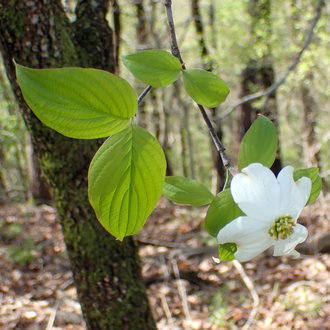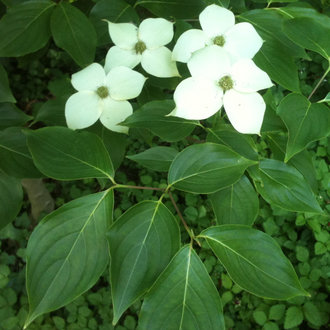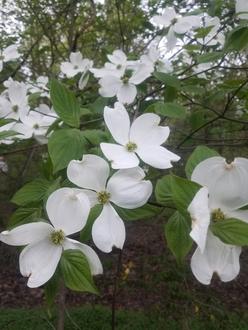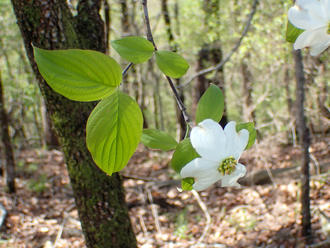Flowering Dogwood (Cornus florida L.)
Also known as eastern dogwood, flowering big-bracted-dogwood; also classified as Benthamidia florida (L.) Spach.
Some authors have proposed separating the Cornus genus into two genera, Benthamidia and Swida. For now we retain the single genus Cornus.
↑Summary
A small flowering tree of Eastern North America, common in forest understories and widely planted in landscaping.
↑Range - Expand
| Legend | Color |
| Native or Not Present | |
| Native |
This tentative map is based on our own research. It may have limited data on Canada and/or Mexico, and there is some subjectivity in our assignment of plants as introduced vs. expanded. Read more in this blog post.
Although this plant occurs somewhere in each of these regions, it may only occur in a small part of some or all of them.
↑Similar Plants
↑Habitat
Found in the understory of a variety of mesic to moist forests, both deciduous and coniferous. Natural habitats include forests in slopes, ravines, bluffs, well-drained portions of floodplains, and swamp margins. Occasional on ridges or dry uplands, where growth is stunted. Also found in anthropogenic habitats including fencerows, power line clearances, abandonded fields, and forest edges and fragments in urban and suburuban areas.
Found on better-drained, lighter-textured soils, and absent from heavy, poorly-drained soils. Common on soils derived from gravel, sandstone, and limestone. Most common on soils with pH between 6 and 7, but can occur on more acidic soils as well. Tolerates some clay in the soil so long as the soil is well-developed and adequately-drained, and tolerates sandy soil on sufficiently moist sites.
Found in all successional stages of forests. It is often among the first woody plants to colonize disturbed sites, but it is highly tolerant of shade and able to persist and reproduce under a closed forest canopy, and is found in old-growth forests and all intermediate stages of succession as well. In pine forests, it tends to appear about when hardwoods start to colonize.
Tolerates a wide range of lighting conditions from full sun to a closed forest canopy, but photosynthesizes optimally at about 1/3rd full sunlight. In full sun exposures, more restricted to moist sites; heavily shaded trees may be more prone to anthracnose and survive best where there is good air circulation.
Found both in habitats that do and do not experience fire. Tolerant of low-to-medium-intensity fire, but usually absent from the driest habitats, such as pine barrens and other pine-dominated forests with few hardwoods.
↑Life Cycle
Seeds germinate in early spring in response to moist, warming conditions. Seedlings establish best on most, well-drained sites. Growth is relatively slow, typically less than a foot a year and slower on shadier and/or drier sites, but the root system grows rapidly. Growth is usually continuous throughout the growing season, but stops temporarily in adverse conditions.
Plants begin flowering quite early, when far from full size; seed production may begin as early as 6 years of age, but seed production is initially low. Good seed crops are typically produced in alternating years, with some years seeing no seeds at all.
This species has a flexible life cycle with a variable growth rate based on lighting conditions. Individuals suppressed by shade can survive as small understory shades for years, growing slowly, eventually reaching large sizes even under a closed canopy. However, when a gap emerges near an existing tree, it responds by growing much more rapidly.
Seeds are primarily distributed by birds, and to some degree by other animals. Seeds exhibit cold dormancy and do not germinate until the subsequent spring, and some remain dormant until their second year, forming a short-term seed bank. Seeds also are adapted to pass through the digestive tracts of birds, typically germinating better after experiencing some degree of physical and/or chemical scarification.
Healthy wild trees tend to live about 80 years, although the lifespan of landscaping plants is often much shorter as they are often planted on less-than-ideal sites.
Mature trees can survive low-intensity ground fires through their thick, insulated bark; more intense fires can kill aboveground parts of the plant, but usually leave the root system intact. Healthy trees will resprout vigorously following top-kill by fire or cutting.
Mortality often occurs from drought on drier sites, or flooding on lower, wetter sites. Trees not completely killed by these factors, can become stressed and later succumb to disease. It can also be stressed by ground-level ozone and acid rain. A common cause of mortality is the introduced dogwood anthracnose (Discula destructiva), which usually hits trees during cool, wet weather following a period of time in which they have been stressed by drought.
↑Faunal Associations
This species has high value to wildlife; the fruits, which have a high fat content and are thus among the more nutritious fruits of their size, are eaten by numerous bird species, as well as various mammals. The foliage, twigs, and to some degree bark, which tend to be more nutritious than that of most woody plants, are browsed by deer and rabbits.
The flowers attract a variety of small pollinators, including halictid bees, adrenid bees, bee flies, and syrphid flies.
There are numerous lepidoptera species that eat this tree in their larval stage, including the northern eudeilinia (Eudeilinia herminiata) and the dogwood thyatirid moth (Euthyatira pudens), Antispila cornifoliella, and the diamondback epinotia (Epinotia lindana), moths that specializes on the Cornusgenus. The dogwood/pecan borer (Synanthedon scitula) eats many species but prefers this and pecans.
It is also eaten by numerous generalists, including the fall webworm (Hyphantria cunea), the curve-toothed geometer (Eutrapela clemataria), the false crocus geometer (Xanthotype urticaria), eastern tent caterpillar (Malacosoma americanum), stinging rose moth (Parasa indetermina), the white-marked tussock moth (Orgyia leucostigma), dark red underwing (Catocala ultronia), confused woodgrain (Morrisonia confusa), Spiramater grandis, the wavy-lined heterocampa (Heterocampa biundata), the red-humped caterpillar (Oedemasia concinna), unicorn caterpillar moth (Coelodasys unicornis), the peacock moth (Automeris io), cecropia moth (Hyalophora cecropia), the oblique banded leaf roller (Choristoneura rosaceana), and other species we could find less information about, including Metarranthis warnerae, Papestra cristifera, the red clearwing borer (Synanthedon geliformis), and the redcheeked looper (Probole amicaria). It is also eaten by the invasive generalist spongy moth (Lymantria dispar), and the introduced ailanthus silkmoth (Samia cynthia) which eats the foliage but does not lay eggs on it.
There are numerous other insects that specialize in feeding on this and other Cornus species, including aphids, leaf and flea beetles, long-horned beetles, twig-borer beetles, spittlebugs, sawflies, and thrips. In addition to these, this species is attractive to a large number of generalist insect herbivores.
↑Uses
Frequently cultivated as an ornamental tree, where it is valued for its showy white flowers and red berries, distinctive bark, attractive form, and ability to grow in shade. It is unfortunately frequently planted on unsuitable to only marginally-suitable sites, where it becomes stressed and is often short-lived. It is best suited to sites that are both well-drained and do not dry out too much, and often does best when shaded by other trees or planted on the north or east side of a building. A poor choice for a street tree, where it deals poorly with pollution and soil compaction. Although it is heat tolerant, reflected heat from paved surfaces can exacerbate drought stress. Modern landscaping practices such as overmulching or aggressive leaf-blowing can also harm this species more than most.
It is often best to plant trees that are entering their third year, which tend to be about 2-3 feet tall. This size is smaller than the plants typically sold in many nurseries. Trees of this size transplant and establish readily due to their shallow root system, but larger trees are more likely to become drought-stressed after planting.
Flowering dogwood is also used for wood; because of its small size, it tends not to be commercially available, and where it is, it tends to be priced quite high as a specialty product. The wood has a high density and excellent shock resistance, yet is relatively easy to work with among woods with such properties. It is mostly used in small specialty objects, including golf club heads, weaving shuttles, bows, mallets, and pulleys. Its usage is limited by the fact that it expands and contracts readily, which typically makes it unsuitable for joining to other materials. It is also highly perishable and susceptible to both rot and insect damage, and thus not suited to applications where it is exposed to the elements.
↑Related Plants
Numerous other Cornus species overlap with this one in range. Although we found some slightly conflicting analyses of the phylogeny of the Cornus genus, it is probably closest-related to the Pacific dogwood (Cornus nuttallii), which is native to the West Coast, and also closely related to Cornus disciflora which is native to Mexico and Central America but not found in the US, to the bunchberry dogwood (Cornus canadensis), a native herbaceous plant, and the kousa dogwood (Cornus kousa), which is native to East Asia. It is not known to hybridize with any species.
The relationship of this genus to other genera is subject to uncertainty; most modern treatments do not place any other genera in this family other than Alangium, which does not occur in North America, and place it as only more distantly related to a few other plant families, most of which do not occur in North America. The closest relatives outside this genus are thought to be the Hydrangeaceae or hydrangea family, the Nyssaceae or tupelo family, and the Loasaceae family.
↑Notes
Flowering dogwood tends to have a positive effect on the soil. Its litter is rich in mineral nutrients such as calcium, and decomposes more rapidly than most of its associates, making nutrients readily available to all plants.
↑Links & External Resources
• Dogwood | The Wood Database (About This Site)
• Flowering Dogwood | Fire Effects Information System (FEIS) (About This Site)
• Cornus florida (Flowering Dogwood) | Illinois Wildflowers (About This Site)
• Cornus florida (Flowering Dogwood) | USDA PLANTS Database (About This Site)
• Flowering Dogwood | iNaturalist (About This Site)
• Cornus florida (Flowering Dogwood) | Missouri Botanical Garden Plant Finder (About This Site)
• Flowering Dogwood | Virginia Tech Dendrology Factsheets (About This Site)
• Cornus florida | Biota of North America Project (BONAP) (About This Site)
• Cornus florida | NatureServe Explorer (About This Site)
• Cornus florida | Flora of North America (About This Site)
• flowering dogwood | Silvics of North America (About This Site)
• Cornus florida | Missouri Plants (About This Site)
• Flowering Dogwood | Maryland Biodiversity Project (About This Site)
• Cornus florida L. | Plants of the World Online (POWO) (About This Site)
• Cornus florida L. (Flowering Dogwood) | Digital Atlas of the Virginia Flora (About This Site)









